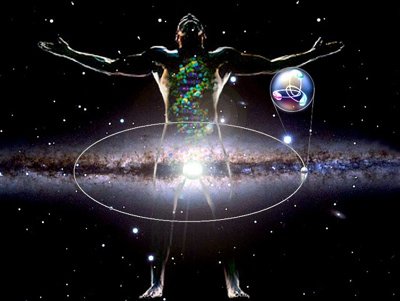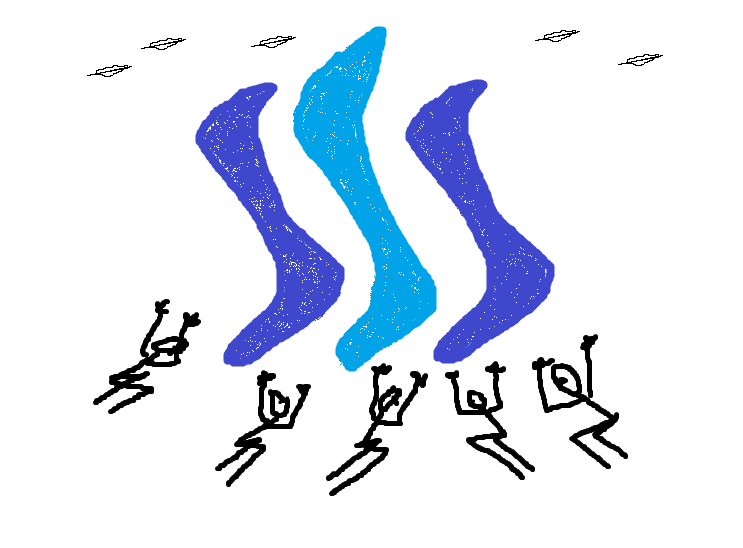Distributed Evolving Organizations
Introduction
Distributed evolving organizations are organizations that reside in cyberspace which leverage evolutionary computation. Evolutionary computation can take the form of human based genetic algorithms, interactive genetic algorithms, or any combination of evolutionary processes which result in a continuous state of improvement of components of it's architecture. The result is a digitized form of smart architecture which continuously evolves to suit the preferences of it's participants.
An early example of human based evolutionary computation as an organization would be the Free Knowledge Exchange Project. This project utilized the human being as a component in the system. A couple of quotes below provide a description of the Free Knowledge Exchange project:
The Free Knowledge Exchange (FKE) project intro-
duces the concept of evolutionary knowledge manage-
ment based on concepts of GA. It used a human-based
genetic algorithm (HBGA) for the task of collabora-
tive solving of problems expressed in natural language
(Kosoruko , 2000a).
-------------
The selection of problems is performed according to their importance, based on expressed interest of participants in each particular problem. This measure of fitness based on the summed interest of all participants is used to include a problem into the generated web pages shown to people. This process happens in inter-faces of HBGA, which generate the interactive WWW pages dynamically. Roulette wheel selection method is used for this purpose. In this way, the problem in which many people are interested will appear in the interfaces more frequently. The frequency of appear-ance of the particular problem in the interfaces and in dynamically generated WWW pages can be thought asa measure of attention the system pays to a particular problem.
Today we are on the cusp of distributed autonomous organizations yet so far not much discussion has been had on how to integrate evolutionary computation processes into distributed autonomous organizations. This article is my attempt to contribute to and help initiate that discussion.
Distributed Evolving Organizations

Distributed evolving organizations (DEOs) are a new breed of social organization that can leverage the trends such as big data, quantified self, Moore's law, artificial intelligence, Reed's law, and even the technological singularity if such an event should take place. These organizations could potentially symbiotically augment the human being through a co-evolutionary process. As humans provide more feedback to the distributed evolutionary organization through their participation the organization can intelligently evolve to fit the preferences of the human participants within the organization. This type of organization could also be described metaphorically as a distributed smart organization because like a the smart home the digital organization would respond to the preferences of it's inhabitants.
Distributed evolving organizations represent a new sort of digitized smart architecture which conforms to the wants and desires of whomever is using. This could for example mean that the user interface continuously adapts to how the user participant likes to interact with the system. Personalization of interface design could be achieved through a personal interactive genetic algorithm so that the interface component of the distributed evolving application/organization learns the favorite colors, patterns, textures, icon placement, widget placement, and more of the participant over time. The personalized interface would be continuously self generating until it approximates to fit the aesthetic preferences of it's owner.
A lot more can be achieved through a distributed interactive genetic algorithm where the sum of all users preferences become feedback for a process of artificial selection. Over a period of time the designs will become increasingly less wrong, less ugly, until it reaches an approximation of universal fitness based on democratically selected search criteria. So in essence design creation which is usually considered a creative process can actually become an evolutionary algorithmic process and this algorithmic process can even be used on the design of the entire distributed evolutionary organization itself.
Steemit is an example of a human-based evolutionary computer
Let's take a closer look at how Steemit works? Steemit currently utilizes the human being as the content producer. Because the human being is currently the primary content producer, the human being can be classified as the innovator. Because the curator is also a human being, the human being can also be classified as the selector. The data or sequences would be the charts, the ranking, the trending mechanism which allows the best innovations (content) to rise to the top of the list.
This means Steemit is currently a human-based evolutionary computer which seeks to use Darwinism mechanisms to evolve high quality fresh content. The 12 hour limitation is what keeps the content fresh and increases the cycling rate.
Steemit can utilize machine intelligence to become an interactive evolutionary computer
Today Steemit is primarily a human based computer because bots have not taken over the role of innovator. In order to produce an interactive evolutionary computer the innovator has to be AI. When AI becomes the journalist for example then the news and other content will be created by AI. Human beings however would still be in the position to curate this content and at this point Steemit may have evolved into an interactive evolutionary computer. In my opinion this would be a very good thing for the holders of Steem Power and it's a good reason not to Power Down because artificial intelligence will likely replace a lot of the content production over the long term, as automated content production catches on.
The Fear of Runaway AI
One of the fears many would have is the run-away AI danger. In order to resolve these fears it is important to note that the human participants and their preferences remain the driving factor in the evolutionary process. Human beings will be able to vote, rank, rate, discuss, every single component within the distributed evolving organization. Humans can rely on reputation, prestige, accountability, and other criteria to give different weight to the feedback from different humans so that overall the best human feedback from the most trusted and qualified rises to the top. If this is in place along with making sure every component is open source then what you can have is an organization which evolves within specific constraints.
Learning Conditional Preference Networks and the Power of Feedback
Feedback is one of the key mechanisms in a distributed evolving organization. In a distributed evolving organization (DEO) the feedback is acquired from the software components. This requires that the design of the DEO be as modular as possible so that any component can be switched in or out. Every component must also be capable of collecting feedback from participants interacting with it, such as a simple feature rating system, an algorithm rating system, or abstract design rating system. Feedback can also become an automatic process through software agents combined with learning conditional preference networks as a way around the user fatigue problem.
Automated Voting and Learning Conditional Preference Networks On Steemit
The Amazon Echo or Siri was used as an example because it's the only practical popular examples of autonomous agent AI. Autonomous agents can go much further than Amazon Echo/Siri and if preferences can be known by an AI then the AI could act as a delegate to the human participant. The autonomous agent could vote on behalf of the human according to preferences the human inputs into the AI or the AI could attempt to learn the “self interest” of the participant using the continuous stream of data the participant provides. It is currently well known that algorithms know us better than we know ourselves and if the trend of Big Data continues it will be likely that our autonomous agents could know our self interest better than we do for ourselves. Why not vote by algorithm if this is the case?
Recommender Bots and Voter Bots on Steemit
Steemit briefly flirted with a recommended section but nothing stops anyone from building recommender bots. These bots could eventually provide the services of voting on behalf of users and on recommending content to users.
Interactive Genetic Algorithms can be used for Preference Guided Self Optimizing Components

In a proper distributed evolutionary organization every component can receive a rating. This would allow voting on every component, every design, every algorithm, even the source code, so that humans are continuously auditing, rating, judging, reviewing, every part of the distributed evolving organization. The role of the interactive genetic algorithm is to use AI to augment human creativity in certain processes such as algorithm design, aesthetics, and more. The genetic algorithm will generate candidate solutions which the human participant would interact with by simply rating each solution. These preferences could then be recorded to a blockchain or distributed ledger anonymously as a number pattern which represents the unique preferences of that participant to the personal interactive genetic algorithm or to a distributed interactive genetic algorithm.
Evolving Distributed Self Optimizing Organizations/Applications

Each and every component within a self optimizing organization is in a continuously redesign state. As participants within the system use the system the system is trained to evolve toward the preferences and use patterns of the participants. Components which don't get used very much do not get trained and as a result will lose design priority but if a component is used a lot the system would know from this feedback that it is a highly valued/prioritized component according to the human participants.
If for sake of example the system is a distributed secure communications forum then as people use each feature they'll have the ability to rate every feature. This rating would give a numerical value to every feature in the system. This rating provides feedback and to avoid user fatigue these ratings do not have to be manual but can be deduced by anonymous usage patterns which create models for different kinds of participants in the system. This information would allow the human developers of the distributed self optimizing application to have a continuous stream of anonymous feedback, at the same time the system itself could be autonomous enough to allocate upgrade funds according to actual usage patterns.
Learning conditional preference networks are a technical mechanism for producing ordinal representations of participant preferences. The learning component allows for a process of continuous improvement so that by algorithm the AI can learn what the participant likes and or wants. It is in the learning conditional preference network component that the human and AI interact closely with the AI functioning similar to Amazon Echo or Siri as a smart autonomous agent for the preferences of the participant. This learning conditional preference network can if it becomes smart enough help to relieve user fatigue and also may even provide for a democratic process which takes place in the background between the participant's conditional preference networks.
References
Code.google.com,. 'Deap - Distributed Evolutionary Algorithms In Python - Google Project Hosting'. N.p., 2015. Web. 5 Mar. 2015.
Hua, H. (2012). Planning meets self-organization: Integrating interactive evolutionary computation with cellular automata for urban planning. Frontiers of Architectural Research, 1(4), 400-404.
Koriche, F., & Zanuttini, B. (2010). Learning conditional preference networks. Artificial Intelligence, 174(11), 685-703.
Kosorukoff, A., & Goldberg, D. E. (2002, July). Evolutionary Computation As A Form Of Organization. In GECCO (Vol. 2002, pp. 965-972).
Wikipedia,. 'Collaborative Filtering'. N.p., 2015. Web. 5 Mar. 2015.

Excellent post! I think it ties in very well to my recent research on human-based stigmergic AI, inspired by your work. Perhaps stigmergy is a personal preference optimization function and it is in every individual's interest to improve that optimization function via a feedback loop, resulting in a recursively self-improving intelligent network.
https://steemit.com/steemit/@miles2045/steemit-as-a-stigmergic-artificial-general-intelligence-with-human-values
Im new so this is all way over my head at the minute but have noticed alot of bots posting and posts about bots. Can they take over the site, then what would happen, Like I said I'm new
Okay, an interactive evolutionary computation environment would be a situation where bots post content and human beings are in the position to curate it. So for example a bot could easily post the news, or be in the role of journalist, by using satellite images, sensors, cameras, and some deep learning mechanisms, to produce stories based on relevant facts. When AI is able to produce content, whether it be journalism or even just nice pictures, the human beings are still the selector. So the process of selection takes place and bots compete for human attention in this atmosphere.
In the long term, human beings may be in a position where bots are being creative, producing content, and we rate it. That is basically an interactive evolutionary computer. Steemit can evolve into something like that if we want and this makes me much more bullish about Steem than most people right now.
References
https://www.theguardian.com/media/2016/apr/03/artificla-intelligence-robot-reporter-pulitzer-prize
https://en.wikipedia.org/wiki/Interactive_evolutionary_computation
Ok thanks for the explanation I understand it better now
The singularity is near.
Read that book. Ray Kurtzweil and Michio Kaku are my tech-Jesus.
Shoutouts to Gordon Moore.
The singularity will never arrive. It's a flawed premise prima-facie.
Computation is not simulation. For simulation you need laws to simulate and someone who understands those laws to codify them.
The hard problem of AI is unlikely to produce a singular "super human" thinking machine.
Or even a borg collective style hive mind for that matter.
No machine can truly be intelligent in the way that a human is intelligent, just like no pack of dogs will ever be intelligent in the way humans are intelligent.
For us to reach the point that is meant by "the singularity", would require a change to what we call intelligence one where we leave out sentience and it would also mean ceding control in hope that the programmer was wiser than us.
But information has virus like characteristics because viruses are a simple biological information carrier.
This is why information spreads in a similar fashion to viruses.
Bad information makes for bad viruses. Good information makes for a strong immune system.
So everyone sees this "singularity" concept takes it in and lets it replicate within their own mind, because it sounds perfectly logical. They either love it or fear it, but they let it in and allow it begin working on them, which actually ends up driving research towards it that probably wouldn't ever occur. This is the problem with both science fiction and pop-sci.
When we say AI what we really mean are systems which act in a autonomous manner and give the illusion of intelligence. Yet despite our best efforts, these machines are subject to the uncanny valley.
As a whole, humans refuse to interact with them because of it.
Machine intelligence is not sentience and thus it evokes in us a primal reaction to reject because it may be a disease carrier.
https://en.wikipedia.org/wiki/Uncanny_valley
AI looks and acts a bit sick because it's information processing substrate lacks the ability to process for sentience.
Sentience itself is a complex biological function and until a machine can truly mimic the biological aspects of a human then they cannot achieve human sentience. If they do build biomimetics then they will be constrained by the limits of the chosen biology.
The real question is what are the actual limits both biological and technological at play?
@dana-edwards So in essence design creation which is usually considered a creative process can actually become an evolutionary algorithmic process and this algorithmic process...
Process complete, ultimate UI preference displayed below.

nice
great post
good job @dana-edwards thank you
Im in it for the long haul!!
I think steemit has much potential to evolve , everything will depend on the creativity and ability of its users .
Are you aware that AI can be creative as well? And that is the idea behind the concept of the interactive evolutionary computation. AI can enhance the creativity of content if used right.
References
https://www.aaai.org/Papers/Symposia/Spring/2008/SS-08-03/SS08-03-006.pdf
On that note, one particular video came to mind:
@dana-edwards @fabiocortes10
Better link on the topic...
http://www.creativeai.net/
Congratulations, is a great post!
Do you like it?:
 My God STEEM
My God STEEM
this is a little techky for me not to say that am not impress with this post.
you can call those organization public contracts. The real sort, not to be confused with "social contracts"